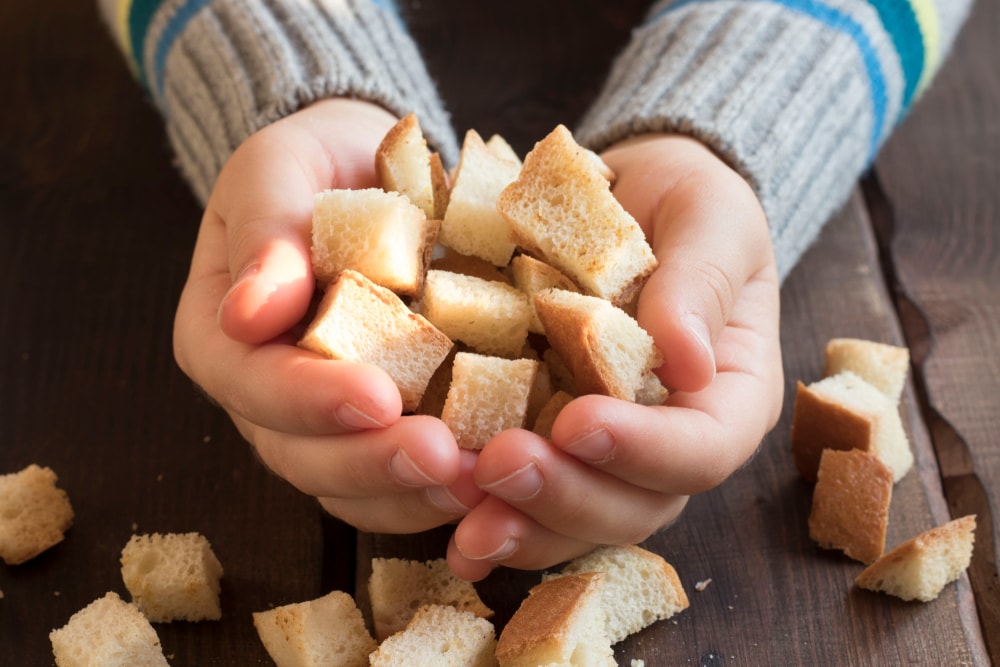In the Brothers Grimm fairy tale Hansel and Gretel, Medieval Germany is in the grips of famine and a woodcutter's family is starving. The woodcutter and his wife decide to abandon their two children, Hansel and Gretel, deep in the forest so they will have two fewer mouths to feed. But Hansel overhears the plot and leaves a trail of breadcrumbs in the woods so he and Gretel can find their way home.
.jpg?width=342&name=Webp.net-compress-image%20(2).jpg) Unfortunately, the crumbs are eaten by birds and the children get lost. They must defeat a wicked witch to ultimately escape being cooked and eaten themselves.
Unfortunately, the crumbs are eaten by birds and the children get lost. They must defeat a wicked witch to ultimately escape being cooked and eaten themselves.
Although Hansel's plan was foiled, today the idea of following a “breadcrumb trail” to a destination or decision is one just about everyone is familiar with.
In digital marketing, breadcrumb paths are most closely associated with web navigation. But there is another way to think of breadcrumbs in marketing.
In Hansel and Gretel, the children leave a path of food in the form of breadcrumbs at a time of great famine.
Today, brands leave a trail of trust signals to guide their buyers to purchase, at a time when trust appears to be in short supply.
Following Trust Signals Along the Breadcrumb Trail
In my last blog post, I wrote about the trust signals that I followed when shopping for a crib mattress for my soon-to-be newborn. Every day, consumers are making similar major purchase decisions for themselves and their families. Whether they realize it or not, they’re following a breadcrumb trail to ensure they can trust the brand, product, or service they’re buying.
In his upcoming book Trust Signals: Brand Building in a Post-Truth World, Idea Grove CEO Scott Baradell defines trust signals as “evidence points that inspire confidence in a brand online.” He goes on to note that trust signals are tools every PR professional should have in their toolkit, as they “combine to drive buyers toward (or away from) your brand.”
When consumers follow one trust signal to the next to find and buy from your brand online, each trust signal is one link in a breadcrumb path to purchase. The path will vary from purchase to purchase and from buyer to buyer, but the idea is always the same.

To gain more insight into the types of trust signals that guide buyers on their paths to purchase, I surveyed a handful of friends, family members, and coworkers with the following question:
“What was your last major purchase, and what were some of the trust signals that led you there?”
From new cars to home repairs and major renovation or DIY projects, some of the answers I found to these questions more surprising than others, but all were insightful.
Here’s what learned:
Online Reviews
Unsurprisingly, almost everyone I spoke with mentioned online customer reviews as one of the major trust signals that influenced their purchase decision.
In the book Trust Signals (the Idea Grove team has had a chance to read Scott's draft manuscript), Scott points out that online reviews are among the most powerful trust signals for your brand. Nearly 90 percent of consumers read reviews before making a purchase and 75 percent of shoppers say they trust online reviews as much as recommendations from friends, family, and colleagues.
Trust badges
 One person shared his new truck-buying experience with me and how trust badges like a Kelley Blue Book Best Buy Award badge, along with several other first-in-class accolades helped seal the deal for him on a new F-150 vs. a Toyota Tundra.
One person shared his new truck-buying experience with me and how trust badges like a Kelley Blue Book Best Buy Award badge, along with several other first-in-class accolades helped seal the deal for him on a new F-150 vs. a Toyota Tundra.
The power of a trust seal for both B2B and B2C products and services cannot be understated. A trust seal is defined as any emblem, badge, symbol or icon intended to quickly establish trust with prospective customers and other audiences online.
Seals from trusted third-party organizations such as the Better Business Bureau, GREENGUARD (in the case of my crib mattress) and, in this case, Kelley Blue Book, communicate and assure buyers of legitimacy, endorsement and status.
Influencer Endorsements
A friend (another new mom) explained that she turned to a popular online influencer, Michelle Pratt with Safe in the Seat, to determine which car seat was best for their growing family. Michelle’s online courses and buying guide made her feel confident not only in her purchasing decision but also in the safety of her child.
I had a similar experience when the influencer Jenn Todryk endorsed the crib mattress I ended up buying—a full year after I saw her first Instagram stories on the topic.
Social purpose
A couple of years ago my parents decided to have their floors redone. Because my mom is a real estate agent and her brother owns his own remodeling business, she didn’t have to look far for a list of vendors for this job.
But while they had several affordable and recommended options, my parents' decision came down to aligned values. They chose to work with a local veteran-owned company that demonstrated their support for active and retired military members versus a vendor without a clear social purpose. They ended up with a quality product and felt good about their investment.

Media Coverage
The same person who shared the importance of a Kelley Blue Book badge in his new vehicle purchase also noted that his research began with reading articles and reviews in popular media outlets like Consumer Reports, Forbes and Bloomberg. These outlets consistently rated F-150 the best truck for him based on his buying priorities.
Social media and online forums
A fellow Grover shared with me her recent experience of choosing a paint brand for the walls and cabinets in her new home. She was trying to decide between Behr and Sherwin-Williams.
While advice from friends, Google research and media coverage convinced her that Behr was the best option for her cabinets, a deep dive on Reddit solidified her decision to go with Sherwin-Williams rather than Behr for her walls. When I asked her why she used Reddit to research a paint purchase, she said that the platform makes it easier to go down topic-focused rabbit holes and that she often turns there for deeper dives into niche subjects.
A Good Website Experience
One couple I know was recently looking for a pool repair service. Following a recommendation from neighbors, they decided to go with a locally owned company vs. a big brand name.
A deciding factor for them was the local vendor's website. The couple determined that although the website was not more than what you’d expect from a local pool retailer, the overall user experience was comfortable and made them feel at home. It was also clear the company was showcasing their own products in photos and videos vs. relying on stock imagery.
Google Ranking
The same couple noted that their pool repair shopping experience wasn’t just about the user experience, but also about the company's Google ranking. It was a positive sign to them that when they Googled “local pool supply store” this shop was one of the first two in the search results—with a number of five-star Google reviews to boot.
Before even clicking to the website, they were able to find images from the company, some brief information and proximity to their residence in the company's Google Business Profile and Google Maps listing.
Online reviews, influencer endorsements, awards, media coverage, Google visibility—how many of these trust signals factored into your last major purchase, either as a consumer or B2B buyer?
And for B2B vendors: what trust signals are you leaving online as breadcrumbs to guide your buyers home to your website?
At Idea Grove, we believe using trust signals to build your brand should be part of an integrated strategy that we call Grow With TRUST. It's all one breadcrumb path after all, right?

 7 min read
7 min read





 4 min read
4 min read

